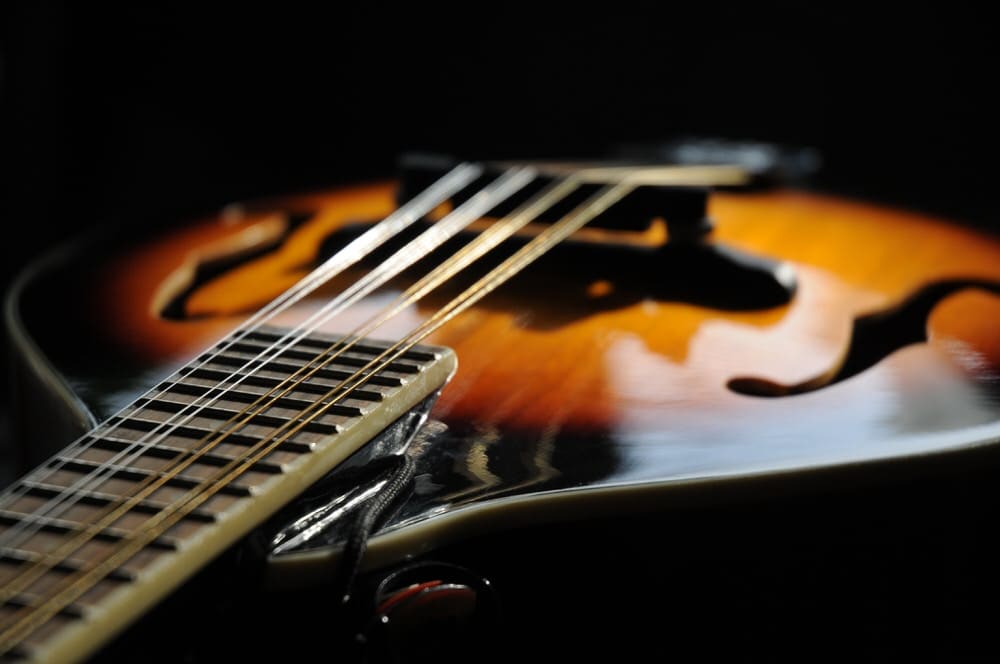Best
High-End Tuner
-
Overall: High-definition display that rotates 360 degrees for easy viewing
-
Best Feature: Electric tuner with bright and colourful display that's easy to read
-
TedScore™: 9/10
Best
Portable Tuner
-
Overall: Highly sensitive vibration sensor that can pick up even the slightest movements
-
Best Feature: Multi-colour display for easy tuning
-
TedScore™: 10/10
Best
Budget Clip-on Tuner
-
Overall: Highly accurate and suitable for use in noisy environments
-
Best Feature: Can be clipped onto the headstock of your mandolin
-
TedScore™: 7.5/10
Standard Mandolin Tuning

A mandolin has 8 strings in pairs of two, and when tuned from low to high, the pairs should play the notes GG DD AA EE.
The standard mandolin tuning notes are G, D, A, and E, typically from low to high, with G being the lowest-pitched string and E the highest. This tuning has a good range and makes chords and melodies easy to play. It’s the tuning most people start with and use in bluegrass, folk, and traditional music.
Aside from the standard mandolin tunings, there are also other common mandolin tuning used. These alternate tunings include open tunings and octave mandolin tuning, also called Irish tuning, often used in traditional Irish music and other styles requiring a lower, richer sound.
Using a tuner to tune a mandolin
Tuning mandolin involves adjusting each string to the correct pitch. Using a tuner to tune your mandolin can be helpful, especially if you’re new to playing the fun instrument.
Simply attach the electronic tuner to the head of your mandolin and pluck each string one at a time. The mandolin tuner will display the string’s pitch, and you can adjust the tuning pegs accordingly until the string is in tune.
Tuning by ear
Tuning by ear can be a bit more challenging, but it’s a great and important skill to develop as a musician. Start tuning off by tuning your A string to a reference pitch, such as a piano or tuning fork. Once your A string is in tune, you can tune the rest of your strings by playing harmonics.
To do this, lightly touch the string at the 12th fret and pluck the string. This will produce a bell-like sound. You can then adjust the tuning pegs until the harmonic matches the pitch of the next string.
Mandolin Strings tuning typically follows the GDAE tuning, with the pairs of strings tuned to the same pitch, creating a bright and resonant sound ideal for various musical styles.
Remember always to check your tuning regularly, as the tension on the strings can change over time. With practice, you can tune your mandolin quickly and accurately, whether using a tuner or tuning by ear.
Tuning Techniques

Tuning with a Tuning Fork
To tune with a tuning fork, strike it against a hard surface and hold it close to your ear. You should hear a sharp, clear, steady tone. Then, pluck the corresponding string on your mandolin and adjust the tuning key until the string’s pitch matches the tuning fork’s pitch.
Tuning with Harmonics
To tune with harmonics, lightly touch the string at the 12th fret and pluck the string. This plucking will produce a harmonic tone. Then, compare the harmonic’s pitch to the same note’s pitch on the corresponding open string. Adjust the tuning key until the pitches match.
Tuning with Reference Pitches
Tuning with reference pitches is useful if you don’t have a tuning fork or other tuning device. You can produce the reference pitches with a pitch pipe or a piano. Simply play the reference pitch and adjust the tuning key until the pitch of the corresponding string matches the reference pitch.
Tuning with Online Mandolin Tuner
Online tuners work by analyzing the sound waves produced by the strings of your mandolin. When you pluck a string, the tuner detects the sound wave’s pitch and compares it to the desired pitch for that string. The tuner then displays the difference between the two pitches and guides you in adjusting the tuning pegs until the pitch matches the desired pitch.
Some tuning apps will give you a reference tone, and you can use this to check each string individually. It will be easier to get tuning roughly in the same note ballpark first, as this will help you fine-tune.
Which are the correct tuning pegs?
It’s not always obvious which tuning peg is for which string. Most mandolins are the same. They have tuners for the G strings and the D strings on the headstock end closest to you.
3 Best Mandolin Tuners

DESIGNED FOR: musicians who play stringed instruments
FEATURES: High-definition display that rotates 360 degrees for easy viewing
OTHER INFO: Faster chip than its predecessor for improved accuracy
Snark ST-8 Clip-On Tuner
When you check the price above, you’ll see there are loads of great places to buy this item. Our personal favorite is Gear4music.
It is the largest music retailer in the UK and fast becoming the most respected online music shop in the US too. Their customer service is excellent, they have competitive prices, really fast shipping, and usually have the longest guarantee.
Most professional musicians use Gear4music, so there is no reason why you shouldn’t too!
- High-sensitivity vibration sensor for accurate tuning
- Electric tuner with bright and colourful display that's easy to read
- It can be clipped onto the headstock of your mandolin and is suitable for use in noisy environments
- The display can be difficult to read in direct sunlight
The professional musician who wrote this article combined many things,
from the product build, manufacturer’s reputation through to feedback
from other users, to create our famous TedScore™.

DESIGNED FOR: musicians of all levels
FEATURES: Compact and lightweight design for easy transport
OTHER INFO: Highly sensitive vibration sensor that can pick up even the slightest movements
D'Addario NS Micro Clip-On Tuner
When you check the price above, you’ll see there are loads of great places to buy this item. Our personal favorite is Gear4music.
It is the largest music retailer in the UK and fast becoming the most respected online music shop in the US too. Their customer service is excellent, they have competitive prices, really fast shipping, and usually have the longest guarantee.
Most professional musicians use Gear4music, so there is no reason why you shouldn’t too!
- Multi-colour display for easy tuning
- It can be clipped onto the headstock of your mandolin and is suitable for use in noisy environments
- Easy to use and highly accurate
- Some users have reported that the battery life is not longer than they would like
The professional musician who wrote this article combined many things,
from the product build, manufacturer’s reputation through to feedback
from other users, to create our famous TedScore™.

DESIGNED FOR: Performances, rehearsals, and studio sessions
FEATURES: Versatile clip-on tuner ideal for a wide range of instruments
OTHER INFO: Comes with an intuitive, light-up display
Chromatic Clip-On Tuner by Gear4music
When you check the price above, you’ll see there are loads of great places to buy this item. Our personal favorite is Gear4music.
It is the largest music retailer in the UK and fast becoming the most respected online music shop in the US too. Their customer service is excellent, they have competitive prices, really fast shipping, and usually have the longest guarantee.
Most professional musicians use Gear4music, so there is no reason why you shouldn’t too!
- Superbly accurate, with a default 440Hz pitch and broad frequency range
- Easy to read with five modes to choose from
- Perform with pitch-perfect accuracy due to precise tuning quality
- None!
The professional musician who wrote this article combined many things,
from the product build, manufacturer’s reputation through to feedback
from other users, to create our famous TedScore™.
Maintaining Tuning
Maintaining tuning on a mandolin is crucial to ensure that your music sounds accurate and in harmony. Tuning your mandolin involves adjusting the tension of the strings to produce the correct pitch.
However, it’s not always easy to maintain tuning, for example, especially if you’re a beginner.

Tips for Maintaining Tuning
Here are some tips to help you maintain tuning on your mandolin:
1. Always tune your mandolin before playing to ensure it’s in tune.
2. Use a reliable tuner to help you achieve accurate tuning.
3. Stretch to tighten the strings before playing to prevent them from going out of tune.
4. Avoid exposing your mandolin to extreme temperatures, which can cause the wood to expand or contract and affect the tuning.
5. Store your mandolin in a protective case to prevent it from getting damaged.
Common Reasons for Losing Tuning
There are several common reasons why your mandolin may lose tuning, including:
1. Strumming too hard or fast can cause the strings to go out of tune.
2. The pairs of strings may not be tuned to each other, causing the mandolin to sound out of tune.
3. Not challenging the strings enough can cause them to lose tension and go out of tune.
4. Inaccuracy in tuning can cause the mandolin to sound off-key.
5. Poor quality strings can affect the tuning of your mandolin.
6. Displaying your mandolin in direct sunlight or near a heat source can cause it to go out of tune.
Tuning A Mandolin
Summary
The mandolin is a small stringed instrument that belongs to the lute family. Learning how to tune a mandolin is a fundamental skill for any player, and it involves adjusting each string to the correct pitch to ensure the instrument produces harmonious and accurate tones.
Remember, tuning a mandolin is not a one-time event. The strings will naturally go out of tune as you play your mandolin. It’s important to check your tuning frequently and make adjustments as needed. If you know any songs, you can play these to see if they sound right. Some tuning apps will give you a reference tone, and you can use this to check each string individually.
Tuning a mandolin can be a bit tricky, but with practice and patience, you will be able to tune your mandolin like a pro. Don’t be afraid to experiment with different tunings while playing mandolin, to find the perfect sound for your playing style.
Using the right tools and practising regularly ensures that your mandolin is always in fine tune and ready to play.
Happy tuning!
Wait, there’s more!!!
Make sure to check out this next article: Best Beginner Mandolin
FAQ's
The standard tuning for a mandolin is G-D-A-E, with the G string being the thinnest and the E string being the thickest.
Yes, you can tune a mandolin with a guitar tuner by setting the tuner to auto and reading the notes G, D, A, and E. However, it is important to note that the much higher note A on a mandolin is an octave plus one step higher than a G on a guitar.
Tuning a mandolin can be challenging because it has eight strings that need to be tuned precisely, and it can be difficult to determine which one string is out of tune when striking them both in unison. Changes in temperature and humidity can cause the instrument to go out of tune.
The mandolin is typically tuned to the octave above the violin, with the standard tuning being G-D-A-E. The G strings are the thinnest and highest-pitched strings, while the E strings are the thickest and lowest-pitched strings.
No, you cannot tune a mandolin like a ukulele. The mandolin has a different tuning and a different number of strings. The standard tuning for a mandolin is G-D-A-E, while the standard tuning for a ukulele is G-C-E-A.











Hey Lewis Turner, got any advice for keeping my mandolin in tune longer? It seems like I’m always tuning it. Thanks for the help
I must express my appreciations for your article, Lewis Turner. The pathway you’ve illuminated for tuning mandolins strikes the perfect chord between tradition and technology. Particularly, the exposition on maintaining tuning was enlightening. My humble mandolin, a companion in my twilight years, often seemed capricious in its tonal stability. Following your advice has rendered it far more consonant with my musical endeavors. A grace, indeed.
I’m new to the mandolin and was curious about the different tuning techniques you mentioned. Could you elaborate on how tuning with harmonics works compared to using a tuning fork? Are there situations where one method is preferable over the other?
Charlie, in my experience, harmonics are great for fine-tuning once you’re close. Tuning forks are more of a starting point. Each has its place, depending on how out of tune your mandolin is.
Fascinating Read. Whilst I’ve Often Tuned Mandolins By Ear, I Wasn’t Fully Aware Of The Nuances Involved With Other Methods. This Article Has Broadened My Perspective Considerably. I’m Eager To Experiment With Tuning Forks. Anyone Else Found This Method Particularly Effective?
Nah, it’s pretty easy once u get the hang of it. Just takes a bit of practice. totally worth it for the pure tone you get.
I’m curious about tuning forks too. Is it hard to get right if you’re new to tuning instruments? Seems a bit intimidating.
loved the section on tuning with harmonics. never thought to apply it on a mandolin. cool stuff.
If I tune my mandolin in a forest, and no one is around to hear it, does it make a sound? Just kidding, solid tips though!
Hey Lewis , I’m digging this article on tuning techniques but wonder if you’ve got tips on making those fine adjustments. My students struggle with this part the most. Maybe it’s the tuner they’re using? Thoughts?
Loved the tuning tips, Lewis! Always struggled with my mandolin but this made things clearer.